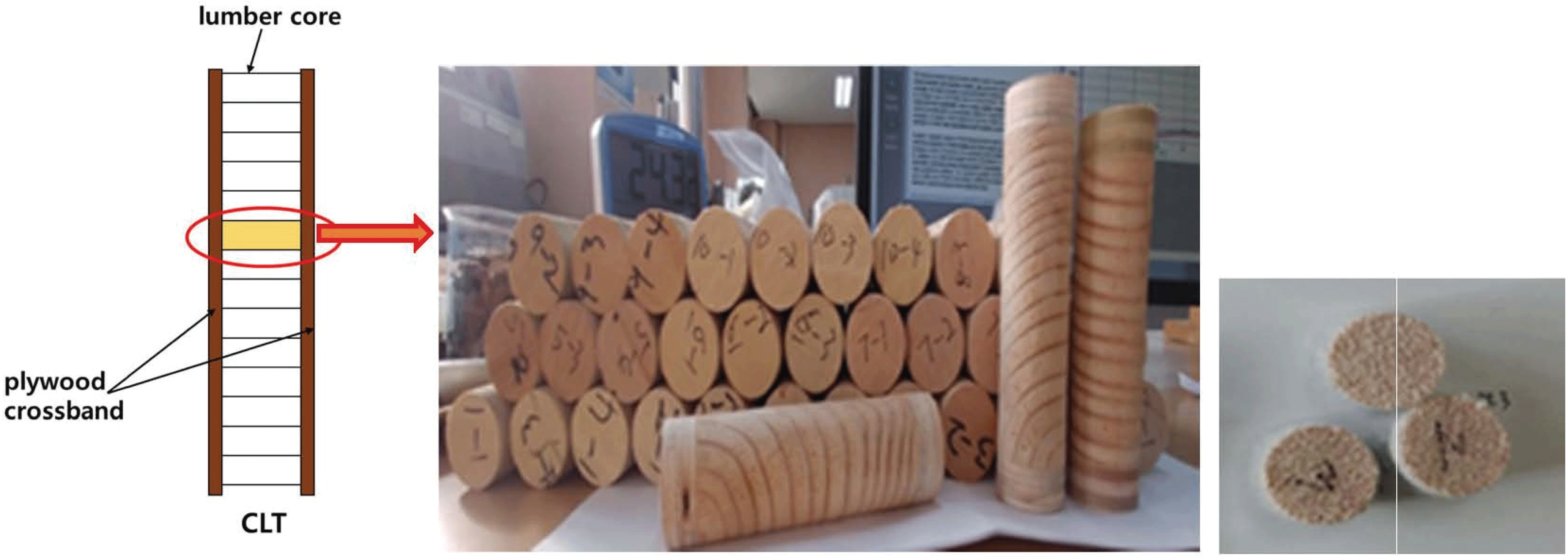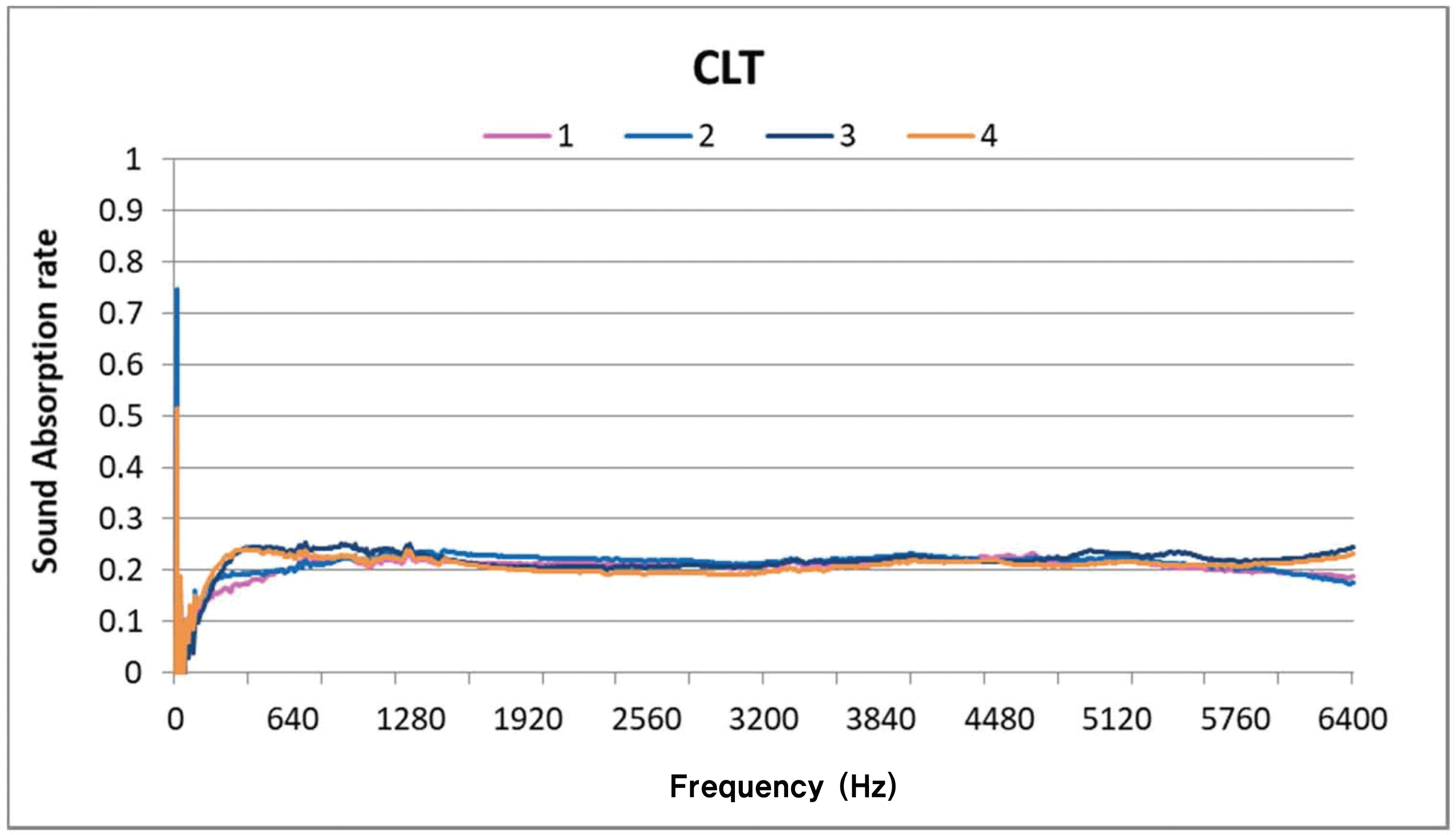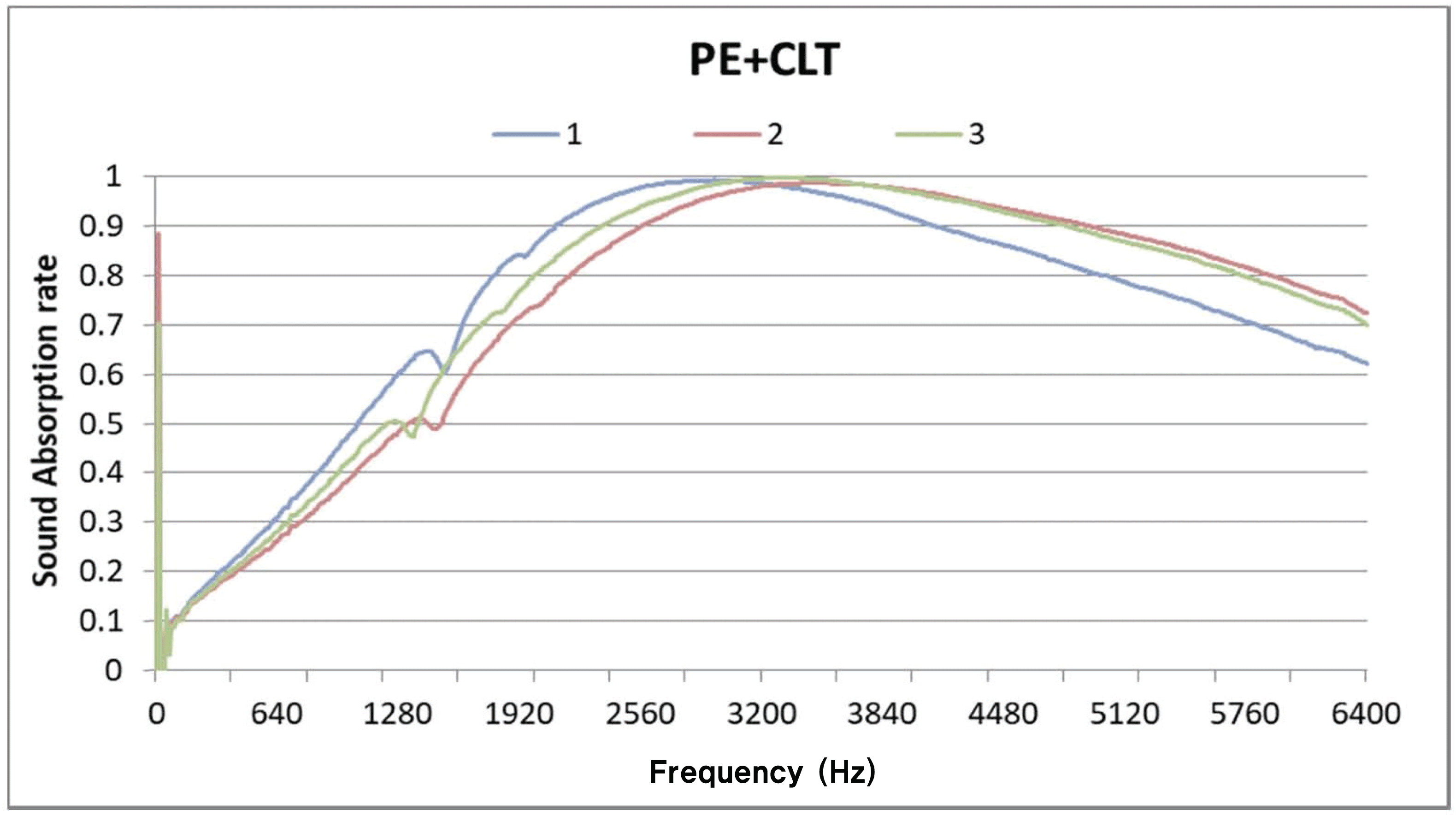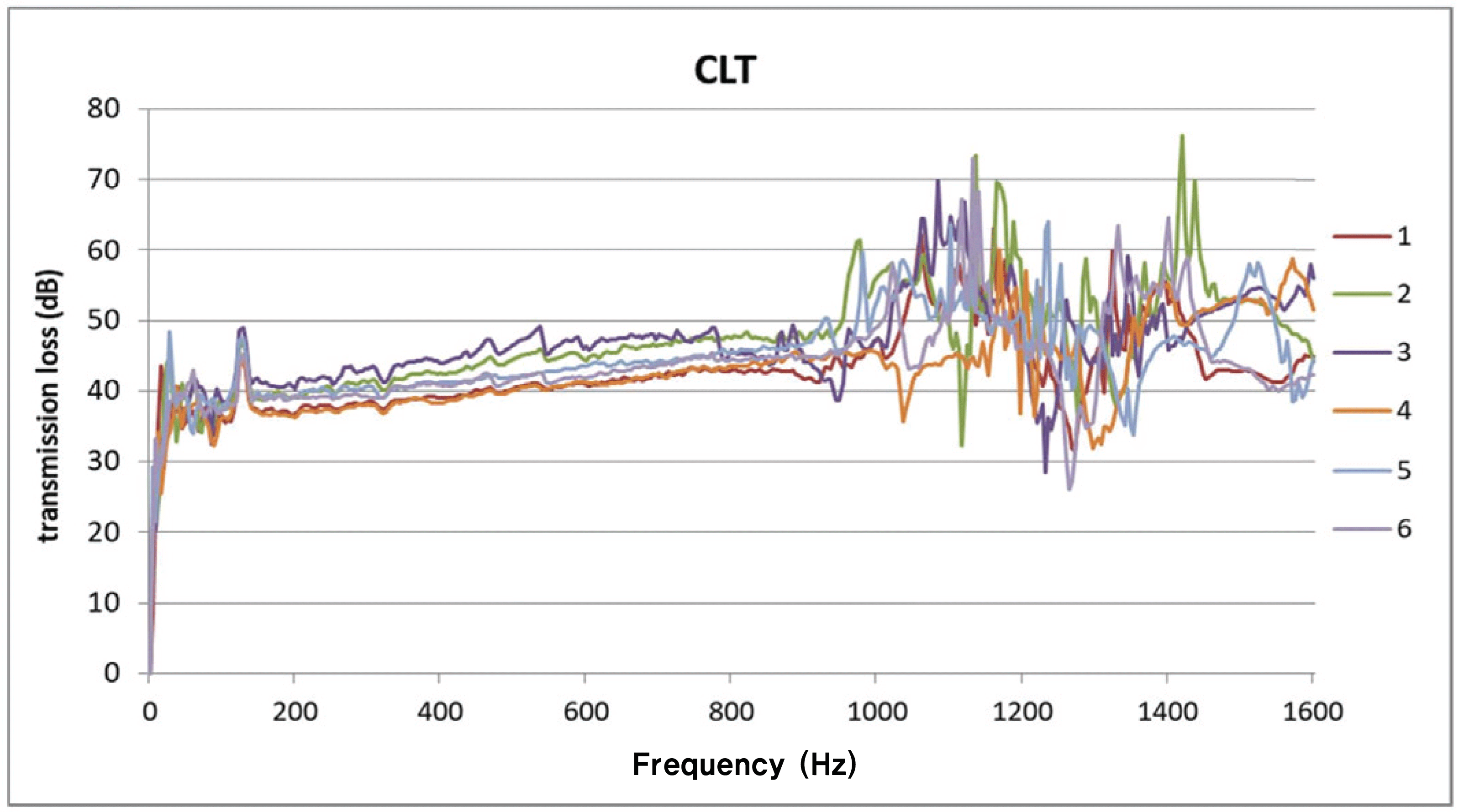1. INTRODUCTION
The larch (Larix kaempferi) wood come from small diameter logs is used as pallet or fuel wood in Korea though it has relatively high mechanical properties such as bending strength and modulus of elasticity in bending etc. This study was started to investigate the possibility of using small larch logs for more effective usages than pallet or fuel. One of such efficient utilization is the structural member for construction of timber buildings. CLT (cross laminated timber) construction has become a new trend in the world, and more people in Korea also have interest in CLT construction. Therefore, it looks a good idea to investigate the possibility of using small larch logs for CLT manufacturing. To increase the possibility of using small larch logs for CLT manufacturing, the expenses for processing of small larch logs and manufacturing of CLT panels shall be minimized. For these purposes, small larch logs were sawn four sides, dried and planed to small square timbers having section size of 90 mm × 90 mm. These small square timbers were glued together laterally to form core panel, and 1,200 mm × 2,400 mm plywood panels were used to cover both surfaces of this core panel to form CLT of the size 1,200 mm × 2,400 mm. Fig. 1.

In the view of acoustical properties of construction materials, (Jang et al., 2018; Kang et al., 2018a; Kang et al., 2018c; Kim et al., 2012; Kim et al., 2015; Kook et al., 2007; Whang et al., 2010) the acoustic properties of board material are well defined in terms of absorption, reflection, impedance and transmission loss. The sound-absorbing materials commonly used in construction include porous materials such as glass wool, gypsum, and similar materials (Kim, 2007).
In this study, to estimate the sound absorption rate and sound transmission loss of CLT panels, small larch square timbers with 90 mm × 90 mm cross section, which were glued laterally to form core panels and 12 mm thick plywood panels were used as cross bands to make three-ply CLT wall panels on opposing both surfaces and the backs of larch square timber core panels, then the sound absorption capability and sound transmission loss of normal CLT wall panels were investigated, and the sound absorption capability compared with those results of polyester based board attached CLT wall panels. From these results, the acoustical usability of CLT wall panels was discussed.
2. MATERIALS and METHODS
In this study, small diameter larch logs having diameter of 120 mm~150 mm were selected, and they were sawn, dried and planed to the square timbers having cross section of 90 mm × 90 mm. These small square timbers were glued laterally with the acetylated vinyl based adhesive to be formed 1,200 mm × 2,400 mm panels which were used as cores for CLT wall panels. Then, structural plywood panels having size of 1,200 mm × 2,400 mm were used as cross band covering the surfaces and the backs of small square timber cores to manufacture CLT wall panels. From these CLT panels, the cylindrical sample specimens for measuring sound absorption coefficients with 28.9 mm in diameter and 110 mm length and for measuring sound transmission loss with 99.0 mm in diameter and 110 mm length were prepared. The mean of apparent density and moisture content of CLT sample specimens were 0.52 g/cm3 and 8.15 %, respectively.
The sound absorption rate of normal and polyester board attached CLT wall panels were measured by two microphone transfer function method using impedance tube kit (B&K company, type 4706), pulse analysis software and a spectrum analyzer (B&K company), as shown in Fig. 2 (Kang et al., 2010; Kang et al., 2012).
In this study, to estimate effect of polyester board attaching on CLT panels, the sound absorption rates of 25 mm thick polyester board with apparent density of 0.06 attached were measured in the frequency range of 100 Hz~6400Hz. During measurement, temperature, relative humidity, atmospheric pressure, the velocity of sound, air density and acoustic impedance were 22. 2°C, 41.00 %, 1017.25 hP, 344.52 m/s, 1.198 kg/m3 and 412.70 Pa/(m/s), respectively.
According to ASTM E 2611-09, specimen was placed on the middle part of the impedance tube as shown in Fig. 3. Transfer matrix method uses the impedance tube which has the sound source part and the sound receiving part and the sample holder is inserted between the two parts as shown in Fig. 3 (Kang et al., 2018b). Total 4 microphones were prepared and the two microphones per each one side and the other side were attached on the impedance tube. The sound transmission loss is calculated from the transfer functions which obtained from each of two microphones on the both sides of the impedance tube. During measurement, the frequency band was 50-1600 Hz, the temperature and the atmospheric pressure were 23°C, 1013.5 hPa, respectively.

3. RESULTS and DISCUSSION
The sound absorption rates of normal CLT wall panels in the frequency range of 100 Hz-6400 Hz are shown in Fig. 4. The X-axis represented the estimated frequency, and the Y-axis represented the sound absorption rate. The highest value of normal CLT wall panels was 0.25, indicating a mean sound absorption ratio of 0.21 in the entire estimaed frequency range. The sound absorption rate of the CLT was relatively low in the whole estimated frequency range and the noise reduction coefficient was about 0.21.

On the contrary, the sound absorption rate of polyester board attached CLT wood panels was over 4 times higher than that of normal CLT wood panels in the frequency range of 2000-4000 Hz as showed in Fig. 5.

The sound absorption rate of polyester board attached CLT wood specimens was increasing with increasing of frequency, which is a typical characteristic of porous sound absorber. (Kang et al., 2011; Kang et al., 2012c) The sound absorption rate of polyester board attached CLT wood panels was 0.4 at 1000 Hz, 0.35 at 1000 Hz, 0.6-0.8 at 2000 Hz, and more than 0.9 at 2500-4000 Hz. The NRC (Noise Reduction Coefficient) was 0.40, which was higher than that of the commercial 11mm thick gypsum board (0.28), which was frequently used as sound absorbing material for office ceiling. It can be concluded that the polyester board attached CLT wood panels could be used as acoustic housing wall materials because of its high sound absorption rates. Fig. 6.

When the sound transmission loss was measured, the diameter of impedance tube was limited by frequency, the diameter was 29 mm for high frequency range and 99 mm for low frequency range. (Kang et al., 2018b) In this study, the sound transmission loss was measured only in a range of 50~1600 Hz using the impedance tube with the diameter of 99 mm for low frequency range because the thickness of CLT sample specimen for measuring transmission loss, 110 mm exceed 70 mm, the maximum capacity of sample holder.
The transmission loss of the CLT was increased as the frequency was increasing. The transmission loss of the 110 mm thick CLT with the density of 0.75 g/cm3 was about 35 dB for frequencies less than 400 Hz, over 40-45 dB for frequencies up to 800 Hz, and 50 dB for a frequency of 1000 Hz, thus, above the frequency of 1000Hz, it was about 50dB, and above the frequency of 1400Hz, it showed above 50dB. The mean sound transmission loss of CLT wood panel in the frequency range of 50-1600 Hz was 45.12 dB and that value at the frequency of 500 Hz was 42.49 dB. According to the regulation of the Ministry of Land in Korea, the transmission loss coefficient of the sound barrier for roads should exceed 25 dB for a frequency of 500 Hz; in this study, the corresponding values of the CLT wall panel were 42.49 dB for 500 Hz. Here, we expected the 110 mm thick CLT could be used as sound insulation materials due to its high sound transmission loss.
4. CONCLUSION
In order to estimate the possibility of improving acoustical properties and to estimate the sound insulation capability of CLT wood panels, sound absorption property of normal and polyester board attached CLT wood panels were measured by the two microphone transfer function method and sound transmission loss of CLT wood panel was measured by the four microphone transfer matrix method. The results of this study were as follows:
The sound absorption rate of normal CLT wood panels showed relatively low value in almost all frequency range.
The sound absorption rate of polyester board attached CLT wood panels showed high value in almost all frequency range.
The polyester board attached CLT wood panels could be used as acoustical housing wall materials because of its high sound absorption rates.
The sound transmission loss of the CLT showed over 30 dB in almost all frequency range, therefore, this kind of panel is expected to be used as sound insulation wall.

